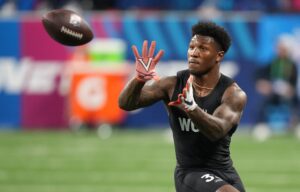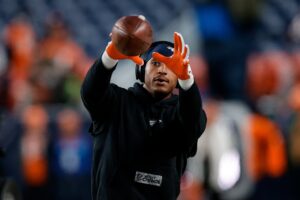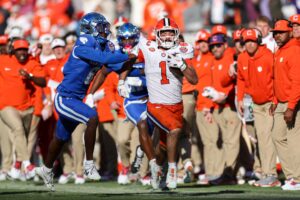Yeah, I said it. Yeah, I believe it.
Rob Gronkowski is significantly overhyped in the eyes of both fans and analysts. Gronkowski is so unbearably celebrated that he is being considered as the greatest tight end to have ever lived, even though several of his positional predecessors have far more decorated careers.
Before you start to belittle, ridicule and excoriate my sanity and professional football acumen, let me divulge some of my “pro-Gronk” disclaimers. For starters, I don’t hate Gronkowski. I think he’s arguably the most talented tight end the game of football has ever seen, and I also feel that he’ll be on the New England Patriots “Mount Rushmore” by career’s end, if he isn’t already.
Now with the compliments out of the way, let the dissection begin.
Rob Gronkowski is the Most Overrated Tight End of All Time
Prior to explaining my in-depth–and accurate–reasoning for my stance, I’ll reveal my truncated list of the greatest tight ends in NFL history, in order, and the reasons why I have each of them ahead of Gronkowski.
- Tony Gonzalez
- Jason Witten
- Antonio Gates
- Shannon Sharpe
- Ozzie Newsome
- Kellen Winslow
- Jackie Smith
- Rob Gronkowski
Statistics
Here’s a thorough breakdown of the career statistical outputs of my top tight ends, as of September 6. The numbers are structured in the following order: Receptions – Receiving Yards – Receiving Touchdowns. The subsequent list is where these players rank in NFL history based off their professional stat lines.
- Gonzalez: 1325 – 15127 – 111
- Witten: 1089 – 11888 – 63
- Gates: 897 – 11192 – 111
- Sharpe: 815 – 10060 – 62
- Newsome: 662 – 7980 – 47
- Winslow: 541 – 6741 – 45
- Smith: 480 – 7918 – 40
- Gronkowski: 405 – 6095 – 68
RECEPTIONS:
2. Tony Gonzalez
7. Jason Witten
22. Antonio Gates
30. Shannon Sharpe
52. Ozzie Newsome
103. Kellen Winslow
153. Jackie Smith
222. Rob Gronkowski
YARDS:
5. Tony Gonzalez
27. Jason Witten
33. Antonio Gates
45. Shannon Sharpe
94. Ozzie Newsome
96. Jackie Smith
143. Kellen Winslow
180. Rob Gronkowski
TOUCHDOWNS:
6. Tony Gonzalez
7. Antonio Gates
43. Rob Gronkowski
71. Shannon Sharpe
71. Jason Witten
148. Ozzie Newsome
159. Kellen Winslow
196. Jackie Smith
Leading the way is none other than Tony Gonzalez. Number one for tight ends all-time in receptions (1,325), yards (15,127) and touchdowns (111), Gonzalez is statistically far and away the greatest player at the position. In 17 NFL seasons, Gonzalez earned 14 Pro Bowl selections, a mark that is tied for the most selections for a single player in league history.
Second is Dallas Cowboys great Jason Witten. Though critiqued for his lack of flash and explosion, the 10-time Pro Bowler has remained one of the game’s most reliable security blankets. Despite having Drew Bledsoe, Tony Romo and Dak Prescott as his quarterbacks throughout his career (just to name a few), Witten has managed to rack up just south of 1,100 catches and 12,000 receiving yards.
Along with Gonzalez, Witten places in the top seven in NFL history in career receptions…as a tight end. Only three other players at that position rank in the top 60 (Gates, Sharpe, Newsome). With 800-plus receptions, 10,000-plus yards, 60-plus scores and eight Pro Bowl selections apiece, Antonio Gates and Shannon Sharpe hold the three and four spots, respectively. Though not immensely embellished number-wise, what makes the resumes of Ozzie Newsome, Kellen Winslow and Jackie Smith so impressive is that they didn’t benefit from a “pass-happy” league. For most of the 20th century, running backs dominated the football landscape. During the five-year stretch from 1977-81, rushers were taken number-one overall in the NFL Draft four times; Earl Campbell and George Rogers were the two most-notable picks. The NFL averaged 10 300-carry runners per season from 2000-2006 until decreasing to six per year from 2007-2010. That quantity then shrunk to below three annually from 2011-2014.
With the substantially-increased importance of quarterbacks, pass-catchers have become more imperative to not only offensive success, but also team success. Coupled with competing in a run-laden game, Jackie Smith played when the NFL regular season was only 14 games. Smith ended his career in 1978, the same year in which the league moved to its current 16-game slate. From the start of his pro tenure in 1963 to 1977, he missed out on 30 potential games. Essentially not having two full seasons of contests to make more on-field contributions, Smith’s statistical outputs were significantly compromised. For Newsome, Winslow and Smith to collectively post a 480-catch, 6,700-yard and 40-touchdown stat line in spite of the limitations of former league structures, their portfolios should be respected.
Though Gronkowski has unquestionably been the top tight end of this decade, his career is nowhere near the “GOAT” stratosphere. As of September 6, Gronk ranked 180th or lower all-time in both receptions (222nd) and yards (180th). His career average stat line is 58 receptions for 871 yards and 10 touchdowns. If he were to meet that yearly average by the end of 2017, he would then rank around 166th and 135th in catches and yards, respectively. “Legendary.” Sure, Gronk does place inside the top 50 in touchdowns, but rushing and receiving touchdowns are often overvalued in terms of mathematically evaluating running backs and pass catchers.
From 2006-2015, New Orleans Saints wide receiver Marques Colston posted two seasons with at least 10 receiving touchdowns. Andre Johnson, a seven-time Pro Bowler, never reached the double-digit plateau. In 10 NFL seasons, Colston tallied 72 touchdowns compared to Johnson’s 70 scores in 14 seasons. From this data, Colston is apparently “better” than Johnson, thanks to his superior scoring mark. Also by that “more touchdowns” logic, Joey Galloway is better than Michael Irvin since he finished with more receiving touchdowns. Yes, some players’ touchdown numbers like Randy Moss (156), Terrell Owens (153) and newly-enshrined Hall of Famer LaDainian Tomlinson (145) are otherworldly, but each of them are still atop the receptions and yards lists at their respective positions, even if they were void of those astronomical score numbers. That being said, many skill position players have scored the majority of their touchdowns in short-yardage situations, despite their individual greatness. Of Tomlinson’s 145 scores, 126 of them came inside the red zone (87 percent).
This red zone narrative applies especially to tight ends:
- Gonzalez: 86/111 scores in the red zone (77 percent)
- Witten 44/63 scores in the red zone (70 percent)
- Sharpe 48/62 scores in the red zone (77 percent)
- Gates 87/111 scores in the red zone (78 percent)
- Gronk 49/68 scores in the red zone (72 percent)
A 75 percent average between these five players.
When a team has a physically-imposing player that collects seven out of every 10 touchdowns from inside 20 yards against a defense with a decreased margin for error, the optics will favor the pass catcher nearly every time.
Supporting Casts
The aspect of supporting casts in sports can be assessed on two sides. First, a number of pieces can both alleviate pressure and eliminate the attention on an individual player. Conversely, having those extra assets can hamper statistical potential. The perfect example is the NBA’s Golden State Warriors after the acquisition of Kevin Durant. While the superstar small forward made an already-explosive offensive team even more difficult to defend with the extra spacing, Stephen Curry’s numbers fell in the process. In his sensational 2015-2016 season, Curry averaged 30.1 points per game on 50 percent shooting. The two-time MVP’s showing dipped to 25.3 points per game on just 47 percent shooting last year. Starting in 79 games in back-to-back campaigns, Curry’s field goal attempts per contest went from 20.2 to 18.3. Draymond Green’s 14.5 points fell to 11.3 in 2017.
Likewise, for my listed tight ends, their statistical outputs were hindered by additional pieces around them.
From 2001-2006, Tony Gonzalez had two running backs that were at the peak of their games during that six-season stretch: Priest Holmes and Larry Johnson. In 2002, Holmes rushed for a career-high 1,615 yards, averaging 115.4 yards per contest. Within that same season, Gonzalez’s 99 targets were his fewest since his 1997 rookie year (54). During his prime years (2001-2004), Holmes earned three Pro Bowl selections and tallied for 5,482 yards, accounting for 23 percent of the Kansas City Chiefs total offensive yards in that span. Kansas City didn’t miss a beat with Johnson, as the successor posted consecutive 1,750-yard seasons from 2005-2006. Gonzalez’s 104 targets in 2006 were his lowest since the Holmes-dominated 2002 campaign.
A teammate of three Pro Bowl wide receivers and three Pro Bowl running backs, Witten was overshadowed by star-level players numerous times in his career. In his first season with the Dallas Cowboys, Terrell Owens garnered 85 catches for 1,180 yards. The future Hall of Famer’s production was a catalyst in Witten being limited to 64 grabs for 754 yards, at the time his lowest marks in those categories since his 2003 rookie year. Dallas boasted two All-Pro performers in DeMarco Murray and Dez Bryant for the 2014 season. Murray achieved career bests in carries (392), yards (1,845) and yards per game (115.3) while Bryant recorded 88 receptions for 1,320 yards in only his second fully-healthy campaign. At the time, Witten’s 64 catches for 703 yards were his lowest totals since 2003.
Alike Witten, Gates also has played with three Pro Bowl rushers; and the one who had the greatest impact on his stats was Tomlinson. In 2005, Gates set career highs in receptions (89), yards (1,101), yards per game (73.4) and targets (140) in just 15 outings. Tomlinson’s historic 2006 was headlined by the record-breaking 28 rushing touchdowns, but the MVP contributed 1,815 yards on the ground. Even with the extra game, Gates didn’t match his 2005 output as he dropped in each of the aforementioned categories.
Sharpe’s best Pro Bowl teammate was none other than Terrell Davis. Though his career was decimated by injuries, the newly-enshrined Hall of Famer had one of the greatest running back peaks in NFL history. Davis ran for 1,750 and 2,008 yards in the 1997 and 1998 seasons, respectively. After getting 80 receptions on 117 targets in 1996, Sharpe’s totals in those areas decreased each of the following two years.
Winslow’s numbers were suppressed due to his Pro Bowl teammates during the Los Angeles Chargers famed “Air Coryell” era of the late 1970’s to mid-1980’s. Newsome and Smith averaged out at four Pro Bowlers who made significant offensive contributions.
The only New England skill position player that has earned a Pro Bowl since 2010 is Wes Welker (2010-2012). Though Randy Moss was a Patriot during Gronk’s 2010 rookie season, he got traded after four games. Albeit Welker and Julian Edelman have been superb slot options, neither of them are transcendent enough to command the same attention as the previously-noted All-Stars.
Durability
Viewers should have a much heavier gripe with Gronkowski’s durability (or lack thereof). He’s a nearly unmatched offensive weapon when on the field and healthy, but he can’t assist a team when he’s a perpetual benchwarmer due to injuries. Below are lists of my top eight tight ends and their total games marks, per the Pro Football Reference website, as of September 6. I didn’t use the popular “games started” stat for two reasons. One, every player doesn’t begin their career as a starter. Two, the site only has the stat recorded since 1970.
- Gonzalez: 270/272 possible regular season games played (99 percent)
- Witten: 222/224 possible regular season games played (99 percent)
- Gates: 204/224 possible regular season games played (91 percent)
- Sharpe: 204/224 possible regular season games played (91 percent)
- Newsome: 198/208 possible regular season games played (95 percent)
- Winslow: 109/144 possible regular season games played (76 percent)
- Smith: 210/226 possible regular season games played (93 percent)
- Gronk: 88/112 possible regular season games played (79 percent)
Number of Full Seasons Available
- Gonzalez: 15
- Witten: 13
- Gates: 6
- Sharpe: 8
- Newsome: 11
- Winslow: 4
- Smith: 12
- Gronk: 2
In his first seven seasons, Gronkowski was unavailable for 24 contests. From this list of tight ends, only Winslow was absent for more than seven games in that span. Since 2007, his freshman year of college, Gronk has only completed two full seasons of football. While Gates and Smith missed ample playing time due to injuries, they were well in their thirties and much separated from the football primes. In May, Gronkowski will only be making his 29th birthday.
As his own coach, Bill Belichick, has uttered ad nauseam, “Dependability is more important than ability.” Belichick stressed that being dependable is not only about being a smart ball player with high-level character but also being counted on to play every Sunday. With his unreliable health history and the standards of his coach, it’s a miracle than Gronkowski is still on this roster.
“B and B Reality”
“B and B,” as in Belichick and Brady. Essentially this is an extension of the supporting casts section as Gronkowski has the greatest support system in NFL history. Belichick and Tom Brady–who are real GOATS unlike Gronkowski–have reigned over the National Football League for the entire 21st century. Let’s just analyze what they accomplished together in the Pre-Gronk era. From 2001-2009, Belichick and Brady guided the Patriots to a 97-30 regular season record, seven AFC East titles and three Super Bowl championships.
What’s comical is that the greatest team in franchise history didn’t win it all. Becoming the first team since the 1972 Miami Dolphins to finish the regular season undefeated, the 2007 Patriots broke a plethora of league offensive records. Tom Brady’s touchdown total was the most notable, as his 50 scoring strikes surpassed Peyton Manning’s 49 from 2004. The aerial achievement helped Brady earn his first of two MVP honors.
In the 24 games Gronkowski was inactive, New England went 19-5 (“but, but he’s so valuable!”). As history would record, Brady collected his unprecedented fifth Lombardi Trophy and his fourth Pete Rozelle trophy. Already impressive, he achieved those feats in record-breaking fashion. After falling behind the Atlanta Falcons 28-3 in February, Brady led the dramatic 31-unanswered-point comeback in the overtime triumph. In the first-ever sudden death in Super Bowl history, Brady finished with a record number of completions (43), attempts (62) and passing yards (466). No Gronk, no problem.
Gronkowski has been gifted the NFL’s greatest coach, the NFL’s greatest player, a 16-game schedule in a passing league and a roster with no other peerless playmakers to minimize his touches. It’s as if God himself presented a Hall of Fame career to Gronk on a silver platter. The fact that he can’t stay off injured reserve and receive his blessing is a tragedy.
Well, I’ve made my point. You can impugn my intelligence as you please. Go ahead and send me the hate notifications saying that I should be banned from social media. Do what makes you comfortable. You can keep your (billy)GOAT, because I don’t need him. Whatever you decide to do, remember this one thing: The truth hurts, just like Gronk.
Main Photo:
Embed from Getty Images






